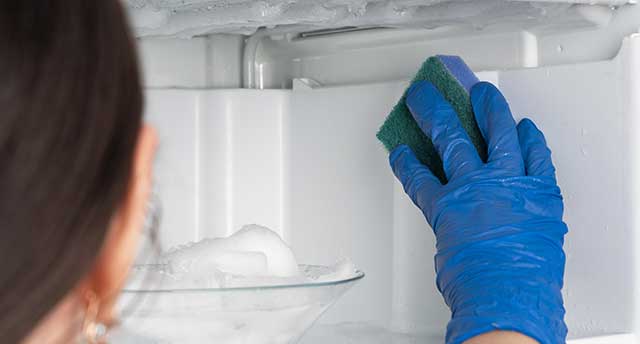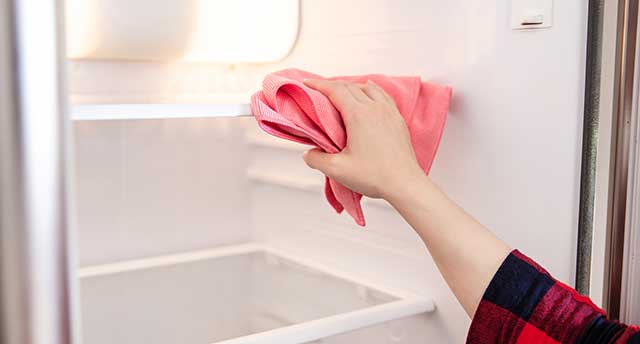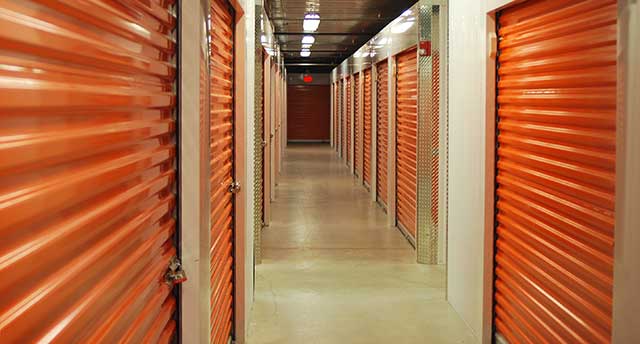Last updated: 13 October 2025
The number one concern when storing a refrigerator (fridge) is mould and mildew. These can quickly develop if the fridge isn’t cleaned or dried properly before storage. Below is a step-by-step guide on how to store your refrigerator correctly and prevent unwanted mould growth — while debunking a few myths along the way.
Turn Off and Defrost Your Refrigerator

Before you store your fridge, disconnect it from power at least 24 hours before moving (or overnight at minimum). This gives the freezer time to fully defrost and allows the compressor gas to settle.
Just like when your refrigerator was first delivered, it needs to stay upright for the compressor to stabilise and avoid internal damage.
If unsure, refer to your owner’s manual for model-specific instructions.
Clean Your Refrigerator Thoroughly

Once your fridge or freezer is unplugged, remove all contents, shelves, and trays, including ice trays. Now it’s time to give your fridge a proper clean. Make sure you remove every crumb or food particle — even small bits can attract pests or contribute to mould while in storage. A clean fridge isn’t just about hygiene; it also prevents odours, pests, and mould, keeping your appliance fresh and ready for use. For tough stains, a mix of warm water, dishwashing soap, and a little baking soda works wonders. Of course, there are also plenty of fridge-specific cleaning products available that do the job just as well.
Soak up moisture and dry your refrigerator

Once your fridge or freezer is sparkling clean, the next step is thoroughly drying it. Any lingering moisture can quickly lead to mould or mildew while in storage. Use a soft, absorbent towel to wipe down all surfaces, and leave the door ajar for as long as possible before moving it. Removing every drop of moisture now greatly reduces the risk of unwanted growth later.
Even with careful cleaning and drying, mould can still develop — it’s a resilient fungus that spreads through tiny spores. You might have heard the tip of placing a tea bag inside the fridge to absorb moisture. While it can help, it has a downside: too much moisture can leak from the bag and leave stains.
A better option? Place a roll of toilet paper inside. It’s naturally absorbent and won’t stain. You can also use moisture-absorbing desiccant packets for extra protection. Either way, taking these simple precautions helps ensure your fridge stays fresh and ready for years to come.
Removal & Storage of the refrigerator

The golden rule when moving or storing a fridge is: always keep it upright. Our removals professionals know exactly how to protect your fridge, using the right equipment and techniques to prevent any damage during loading and transport. Placing a fridge on its side, even briefly, can cause mechanical issues that may render it unusable — so this is one rule you don’t want to break.
If your fridge is going into a warehouse or self-storage unit, we recommend keeping the doors slightly open using a piece of cardboard. This allows air circulation and helps prevent moisture build-up.
When storing a fridge in a shipping container or for international moves, this method isn’t possible due to the protective wrapping required for transit. In these cases, our professionals wrap the fridge carefully, leaving a small gap inside the doors to allow the padding to absorb any excess moisture. For extra peace of mind, you can also add a toilet roll or desiccant packets inside to keep moisture at bay.
With just a little extra care and preparation, your fridge will stay protected and ready to use when it comes out of storage — saving you time, money, and stress in the long run.
Palmers Tip:
A little preparation goes a long way. Spending an extra half hour cleaning, drying, and positioning your fridge properly can help it last years longer — and ensures it’s ready to plug in the moment it comes out of storage.

